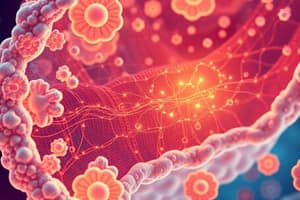Podcast
Questions and Answers
What is the primary difference between simple diffusion and carrier-mediated transport in terms of kinetics?
What is the primary difference between simple diffusion and carrier-mediated transport in terms of kinetics?
- The rate of uptake of carrier-mediated transport is dependent on the external concentration of the substrate, whereas simple diffusion is not. (correct)
- Carrier-mediated transport is limited by the concentration of the substrate, whereas simple diffusion is not.
- Simple diffusion is always faster than carrier-mediated transport.
- Simple diffusion is a more selective process than carrier-mediated transport.
What is the function of a selective carrier protein in facilitated diffusion?
What is the function of a selective carrier protein in facilitated diffusion?
- To decrease the rate of uptake of the solute.
- To increase the concentration gradient of the solute.
- To inhibit the transport of the solute.
- To undergo a conformational change to allow the passage of the solute. (correct)
What is the term for the transport of one solute coupled with the transport of another solute in the same direction?
What is the term for the transport of one solute coupled with the transport of another solute in the same direction?
- Symport. (correct)
- Facilitated diffusion.
- Uniport.
- Antipport.
What is the relationship between the Km of a transporter and its affinity for the substrate?
What is the relationship between the Km of a transporter and its affinity for the substrate?
What is the term for the transport of a solute out of the cell coupled with the transport of another solute into the cell?
What is the term for the transport of a solute out of the cell coupled with the transport of another solute into the cell?
What is the name of the family of transporters that mediate facilitated glucose transport?
What is the name of the family of transporters that mediate facilitated glucose transport?
What is the primary source of energy for primary active transport?
What is the primary source of energy for primary active transport?
What is the net result of the Na+/K+-ATPase pump in the plasma membrane?
What is the net result of the Na+/K+-ATPase pump in the plasma membrane?
What is the role of insulin in regulating GLUT4?
What is the role of insulin in regulating GLUT4?
Which type of transport does not require energy?
Which type of transport does not require energy?
What is the result of the phosphorylation of the Na+/K+-ATPase pump?
What is the result of the phosphorylation of the Na+/K+-ATPase pump?
What is the function of the Ca2+-ATPase pump in the endoplasmic/sarcoplasmic reticulum?
What is the function of the Ca2+-ATPase pump in the endoplasmic/sarcoplasmic reticulum?
What is the primary mechanism by which solutes move from one side of the membrane to the other along their concentration gradient?
What is the primary mechanism by which solutes move from one side of the membrane to the other along their concentration gradient?
Which type of transport involves the movement of solutes against their concentration gradient, requiring energy expenditure?
Which type of transport involves the movement of solutes against their concentration gradient, requiring energy expenditure?
What is the role of the octanol-water partition coefficient (Kow) in membrane transport?
What is the role of the octanol-water partition coefficient (Kow) in membrane transport?
Which type of transporter is responsible for the transmembrane movement of ions and hydrophilic molecules?
Which type of transporter is responsible for the transmembrane movement of ions and hydrophilic molecules?
What is the characteristic of a symporter?
What is the characteristic of a symporter?
Which statement is true about the Na+/K+ ATPase transporter?
Which statement is true about the Na+/K+ ATPase transporter?
Flashcards are hidden until you start studying



